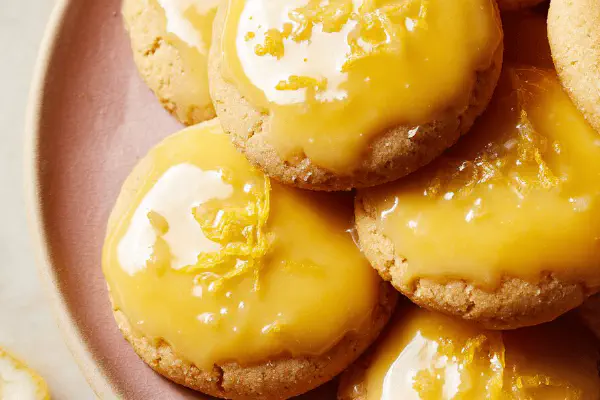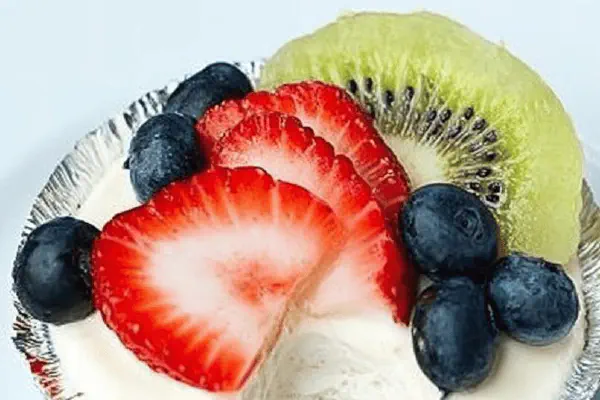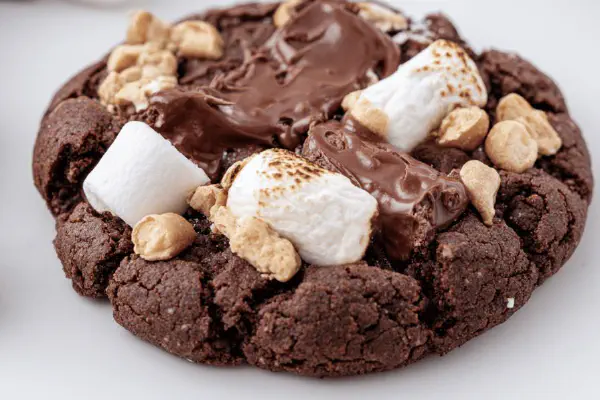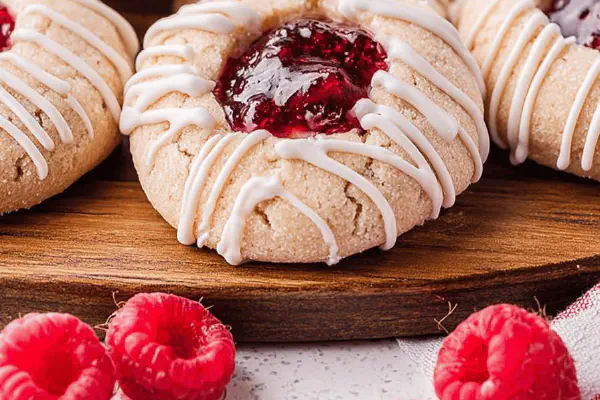Mirror-Glazed Lemon Cookies

E
By Emma
Certified Culinary Professional
•
Recipe tested & approved
Butter and sugar creamed to soft peaks, zesty citrus tweak, flour swapped for spelt, baking powder swapped for baking soda for subtle lift. Whites from eggs whipped for a glossy glaze tinted sunny yellow, a touch of honey added for shine and depth. Dough chilled for texture, sliced thin for delicate crispness, baking timed by golden edges, not the clock. Final glazing mimics sunny side up eggs, sweet but not too sweet, pops on tongue, with a faint tang and snap. Cookies hold shape, stay tender but firm. Expect buttery aroma, lemon zing, and sweet glimmer on top. Comfort in every bite, echoes from past batches and tweaks.
Prep:
40 min
Cook:
20 min
Total:
Servings:
1 dozen
#dessert
#cookies
#lemon
#spelt flour
#glaze
#baking techniques
Start with butter softened not melted. Cream it well with sugar till almost fluffy. Add lemon zest; don’t skip zest or you lose depth. Switched from flour to spelt—more nutty, lighter chew; sometimes I use half white, half spelt. Baking soda swapped in for powder—you’ll see color difference. Egg whites in glaze bring length and shine not just thickness. Honey added for subtle floral sweetness, keeps glaze glossy longer. Chill dough well or it spreads too much. Watch oven—edges tell you when done better than timer. Glazing tricks: reserve a bit for yolk tint, thin but stable glaze—balance water right. Looks like sunny eggs on a plate, bites like buttery lemon snap. Learned a lot about texture here, trial and error. Practice makes perfect. Sweet, tart, firm yet tender. Cooking is listening, smelling, feeling dough and glaze changes. Armed with intuition, a little patience, rewards come. This cookie—worth the wait.
Ingredients
- 135 ml (1/2 cup plus 2 tbsp) unsalted butter, softened
- 180 ml (3/4 cup) cane sugar
- 1 large egg
- Zest of 1 large lemon
- 480 ml (2 cups) spelt flour
- 5 ml (1 tsp) baking soda
- Pinch of fine sea salt
Glaze
- 850 ml (3 1/2 cups) powdered sugar
- 2 egg whites
- Honey, 15 ml (1 tbsp)
- Water as needed
- Yellow gel food coloring
About the ingredients
Butter should be room temperature but firm to avoid greasy dough or flat cookies. Cane sugar replaced white for subtle molasses hints. Tried spelt flour instead of all-purpose for extra nuttiness and tender crumb—watch dough hydration; spelt absorbs liquids differently. Baking soda replaces baking powder, integrating with lemon’s acid for balanced rise and color. Salt is crucial to cut sweetness. For glaze, real egg whites give glossy shine and structure; using pasteurized eggs safer if worried about raw whites. Honey is a game-changer for sheen, flexible texture, and aroma. Adjust water dropwise to get spreadable yet thick glaze, watch not to dilute the intensity. Food gel colors won’t run like liquid dyes. Whole process benefits from prepping ingredients and understanding their roles—a good base here saves headaches later.
Method
Dough Preparation
- 1. Cream butter and sugar together, don’t rush. Beat till pale, fluffy but not melting. Gets air in, helps rise and texture. Remember, cold butter kills rise.
- 2. Add egg, then lemon zest. Stir or slow mix; overbeating egg breaks structure. The lemon zest—don’t skimp. It’s your fresh bite, aroma popping here.
- 3. Sift spelt flour, baking soda, salt together. Baking soda needs acid, that lemon zest does the job, slight tang but balanced.
- 4. Work flour mixture in gently with wooden spoon or spatula. Avoid toughening dough; I once overmixed, rock-hard cookies followed.
- 5. Form dough into a log approx 7 cm diameter (just under 3 inches). Wrap tight in plastic wrap. Refrigerate at least 2 hours—don’t skim this step.
- Dough firms, flavors marry, dough easier to slice without crumbling or spreading.
Baking
- 6. Oven rack at middle position. Preheat to 175 °C (350 °F). Oven temp matters; too hot scorches edges, too low dries cookie out.
- 7. Unwrap chilled dough, slice into thin rounds—about 0.5 cm thickness. Uniform slices means even bake. If slices too thick, cookies stay doughy inside.
- 8. Place slices with room on parchment-lined baking sheet. Crowding causes uneven bake and chewy middles.
- 9. Bake 12 to 18 minutes. Watch edges; when golden yellow turns light brown, and tops feel set but still springy, pull them. Smell is key—nutty scent, faint lemon. Look for little cracks forming.
- Remove immediately to cooling rack; otherwise residual heat cooks dough further messing texture.
Glazing
- 10. Combine powdered sugar, egg whites, and honey in mixing bowl. Whisk to firm but spreadable glaze. Add water incrementally; too thin glaze runs off, too stiff gums up.
- 11. Reserve about 120 ml glaze for decoration. Keep that plain white.
- 12. Thin glaze over cooled cookies with offset spatula or small knife. Let dry until tacky – about 10 minutes. This layer is your base mirror.
- 13. Blend yellow gel coloring into glaze reserve until vibrant sunny yellow, mimics yolk.
- 14. Drop tiny spoonfuls of yellow glaze into center of each cookie—bright spot like egg yolk in sun. Spread slightly if you want uniform ‘yolk’ shape but don’t overdo; imperfections add charm.
- 15. Air dry glaze at room temperature until fully firm and shiny. No rush; glaze gains snap and crackle when thoroughly dried.
Cooking tips
Creaming butter and sugar well is where air incorporation starts cookie lift. Over or under cream and texture breaks. Mixing egg slowly keeps emulsion stable. Integration of dry ingredients demands gentle folding—not beating—to avoid gluten development and toughness. Chilling dough cold lets flour hydrate, fat solidify, avoiding spreading and flattening. Slicing dough thin ensures balance between crisp edges and tender centers, slices should not crack, indicating dryness. Baking by visual cues beats timers—golden edges, set tops, and scent signals. Remove promptly to stop carryover cooking. Glaze consistency directly affects finish. Thick glaze dulls, thin glaze runs off. I always test on a plate first. Reserving uncolored glaze for central egg ‘yolk’ adds visual pop and layered texture. Drying times vary by humidity; patience vital. Air drying produces crisp shell—no humidity please. This entire process requires focus on texture and timing, which comes from experience more than instructions.
Chef's notes
- 💡 Butter temperature matters—room temp but firm not soft. Too soft and dough spreads like pancake; too cold and mixing’s a fight. Cream sugar gradually, beat just till fluffy but no melting. Air in but stable; careless beats kill structure.
- 💡 Use fresh lemon zest. Skip it, and you mute the cookie’s zing. Zest blends acid with subtle oils; acid triggers baking soda for that gentle lift and browning. Fold dry ingredients carefully. Overmix gluten wakes tough and hard cookies.
- 💡 Dough chilling really changes texture. Log shape, wrap tight. At least 2 hours minimum or overnight if you want slices neat and crumbly-free. Cold dough slices thinner, holds form. Skip chill, cookies flatten and lose texture.
- 💡 Watch oven smells and visuals, not time alone. Edges gold, faint crackle near rim, top slightly springy. Use these changes over timers; latency in heating means alone timers cause disappointment.
- 💡 Glaze thickness critical. Whisk egg whites and sugar to spreadable but not runny. Water drop by drop. Too thin glaze runs off, loses sheen. Too thick dulls, cracks unevenly. Reserve some plain white for ‘yolk’ spot, bright yellow tint spreads shiny pop.
Common questions
Can I use all-purpose flour instead of spelt?
Yes but texture changes. Spelt absorbs liquids differently; dough hydration shifts. Dough might feel wetter or stiffer. Adjust liquids slightly, expect less nutty chew.
What if glaze cracks after drying?
Usually too thick or dried too fast. Try thinner layer next time. Humidity matters too; dry air quickens, causing crackle. Room temp ageing helps. Add honey carefully.
How to store cookies?
Airtight container best. Fridge okay for warm climates, but glaze dulls. Room temp keeps texture but watch humidity. Freeze dough if needed; slice chilled frozen log directly for best slicing.
Can I use pasteurized egg whites safely?
Yes safer for raw use. May whip differently but works well in glaze. Balance sugar to stabilize. Store-bought often labeled for no bacteria risks.



